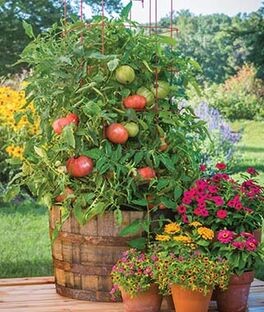Growing Vegetables in Containers
- 2020-07-09
- By mkirk
- Posted in The Garden Buzz
By Kathi Thistlethwaite, Colorado Master Gardener
This is the first of a six-part series focusing on container gardening in Colorado.
While most vegetables can be grown in containers, follow these steps to help your vegetables thrive. Gradually acclimate your vegetables to the outdoor conditions before you put them outside permanently. This is known as hardening off and should be done with all potted cultivars.
Choose containers that please you and give you the look you seek in your landscape. The larger the container, the more soil and moisture it holds. Material and shape are mostly a matter of preference, as long as there is good drainage and the container is made from a food-safe material. When choosing your containers, remember that those made of metal get too hot and treated wood can leach chemicals into the plants. Containers should be 12 inches in diameter or larger.

Photo: no-dig-vegetablegarden.com 
Photo: burpee.com
Use a high quality potting soil. If the soil you choose isn’t pre-fertilized, add a granular fertilizer to your container and mix well with the soil before planting.
Vegetables in containers need to be kept evenly moist but not wet. Put your finger in the soil to the depth of an inch. If it’s dry, it’s time to water. Check your containers daily and even twice daily in hot, dry weather. Roots are above ground and will dry out more quickly than if they were in-ground.
Place your vegetable containers where they will receive six hours of sun daily, except cool season crops which should be kept in partial shade.
Here are some vegetables that grow well in containers:
- Carrots: Use a container double the height of the variety you will grow.
- Cucumbers and Squash (zucchini and summer squash): Choose bush rather than vining cultivars. A container can quickly be filled by one plant. Place a trellis in the pot for support.
- Eggplant: Fairly sensitive to cool temperatures (lower than 50 degrees).
- Leafy greens: Snip and snip again for multiple harvests! This includes lettuce, kale and spinach.
- Peas: Put tall supports in the container and water frequently.
- Peppers: Whether a bell or hot variety, peppers do well in containers. Delicious peppers are great for pickling, preserves and salsas.
- Potatoes: Look for types that mature early. Some potatoes can take up to 120 days to mature.
- Radishes: Containers don’t have to be that large for this spring vegetable.
- Tomatoes: Need a support system. Use a tomato cage or fasten the plant to a tall stake to keep it upright.
The popularity of growing vegetables in containers is on the rise. Smaller, more compact cultivars specifically intended for containers are widely available. They give us an alternative to in-ground gardens, and provide interest and dimension to our surroundings. It’s easier than ever to enjoy the satisfying and health-giving benefits of growing our own vegetables. Bon jardinage!
Next time: All about fall containers
Horticulture Resources
- Garden Buzz Archives
- CSU Extension Resources
- Colorado Master Gardener Program
- Foothills to Plains Native Plant Master Program
- Native Bee Watch Community Science Program
- The Co-Hort Blog
- PlantTalk Colorado
- Soil Testing
- Plant Select
- Emerald Ash Borer
- Japanese Beetle
- Colorado State Forest Service
- Ask an Expert


